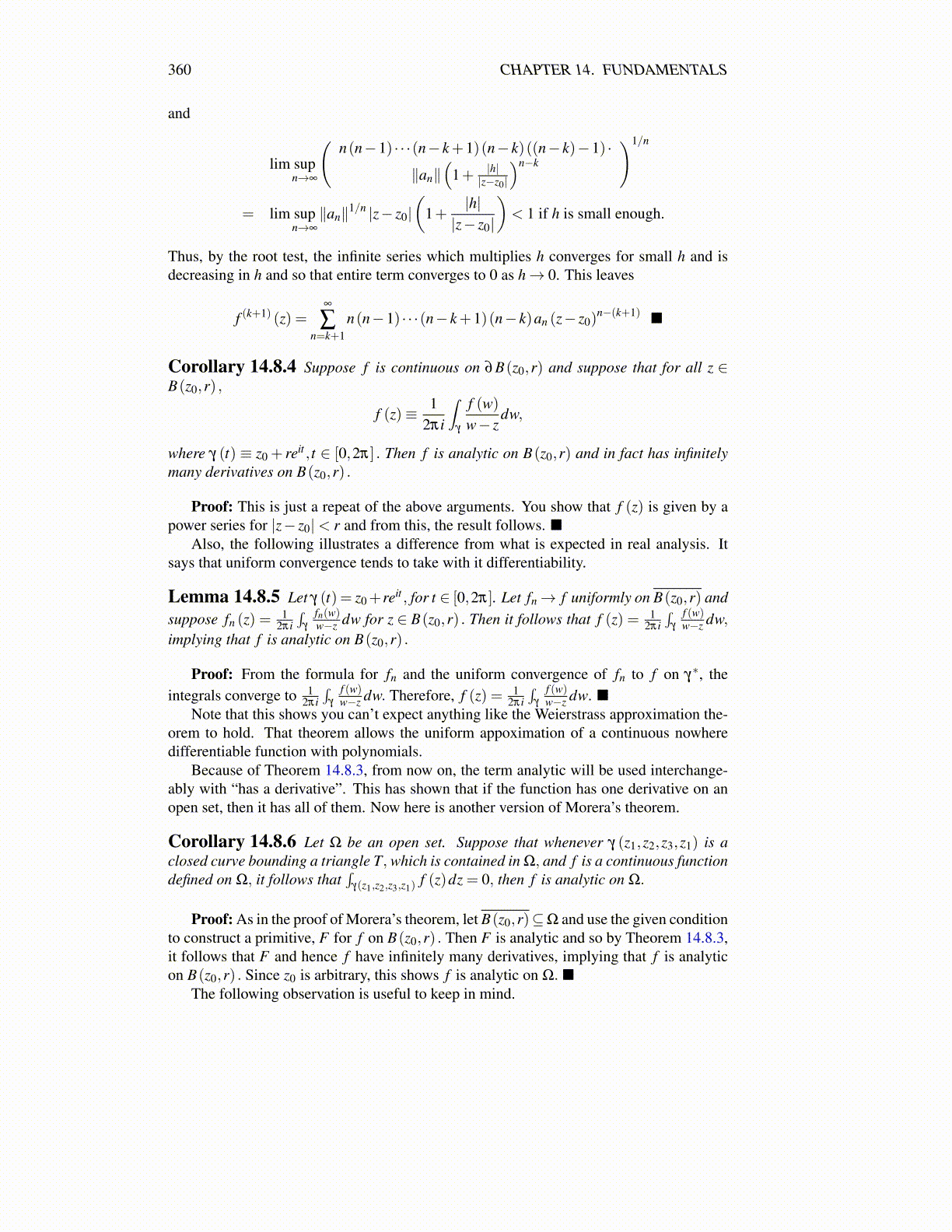
360 CHAPTER 14. FUNDAMENTALS
and
lim supn→∞
(n(n−1) · · ·(n− k+1)(n− k)((n− k)−1) ·
∥an∥(
1+ |h||z−z0|
)n−k
)1/n
= lim supn→∞
∥an∥1/n |z− z0|(
1+|h||z− z0|
)< 1 if h is small enough.
Thus, by the root test, the infinite series which multiplies h converges for small h and isdecreasing in h and so that entire term converges to 0 as h→ 0. This leaves
f (k+1) (z) =∞
∑n=k+1
n(n−1) · · ·(n− k+1)(n− k)an (z− z0)n−(k+1) ■
Corollary 14.8.4 Suppose f is continuous on ∂B(z0,r) and suppose that for all z ∈B(z0,r) ,
f (z)≡ 12πi
∫γ
f (w)w− z
dw,
where γ (t) ≡ z0 + reit , t ∈ [0,2π] . Then f is analytic on B(z0,r) and in fact has infinitelymany derivatives on B(z0,r) .
Proof: This is just a repeat of the above arguments. You show that f (z) is given by apower series for |z− z0|< r and from this, the result follows. ■
Also, the following illustrates a difference from what is expected in real analysis. Itsays that uniform convergence tends to take with it differentiability.
Lemma 14.8.5 Let γ (t) = z0+reit , for t ∈ [0,2π]. Let fn→ f uniformly on B(z0,r) andsuppose fn (z) = 1
2πi∫
γ
fn(w)w−z dw for z ∈ B(z0,r) . Then it follows that f (z) = 1
2πi∫
γ
f (w)w−z dw,
implying that f is analytic on B(z0,r) .
Proof: From the formula for fn and the uniform convergence of fn to f on γ∗, theintegrals converge to 1
2πi∫
γ
f (w)w−z dw. Therefore, f (z) = 1
2πi∫
γ
f (w)w−z dw. ■
Note that this shows you can’t expect anything like the Weierstrass approximation the-orem to hold. That theorem allows the uniform appoximation of a continuous nowheredifferentiable function with polynomials.
Because of Theorem 14.8.3, from now on, the term analytic will be used interchange-ably with “has a derivative”. This has shown that if the function has one derivative on anopen set, then it has all of them. Now here is another version of Morera’s theorem.
Corollary 14.8.6 Let Ω be an open set. Suppose that whenever γ (z1,z2,z3,z1) is aclosed curve bounding a triangle T, which is contained in Ω, and f is a continuous functiondefined on Ω, it follows that
∫γ(z1,z2,z3,z1)
f (z)dz = 0, then f is analytic on Ω.
Proof: As in the proof of Morera’s theorem, let B(z0,r)⊆Ω and use the given conditionto construct a primitive, F for f on B(z0,r) . Then F is analytic and so by Theorem 14.8.3,it follows that F and hence f have infinitely many derivatives, implying that f is analyticon B(z0,r) . Since z0 is arbitrary, this shows f is analytic on Ω. ■
The following observation is useful to keep in mind.